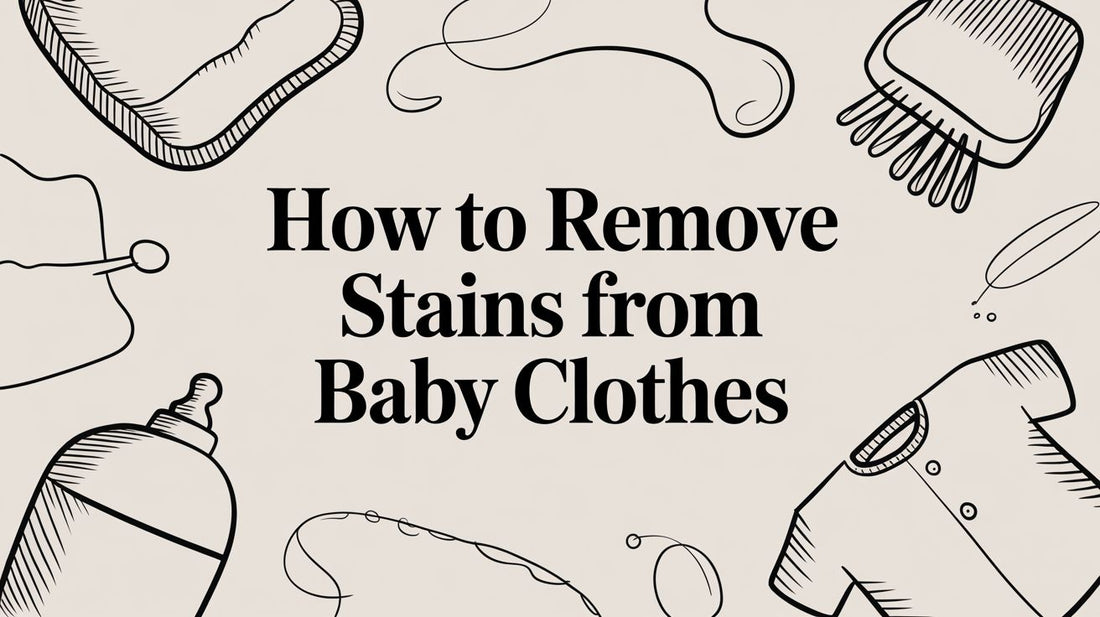
When it comes to baby clothes, the secret to stain removal is pretty straightforward: move fast and pretreat with the right stuff. Seriously, that's half the battle. For protein-based messes like milk or spit-up, an enzyme cleaner is your best weapon. For those vibrant fruit and veggie purees, a simple vinegar soak works wonders. Getting these first steps right before the garment ever sees the washing machine can rescue almost any outfit from the dreaded stain pile.
Your Guide to Winning the Baby Stain Battle
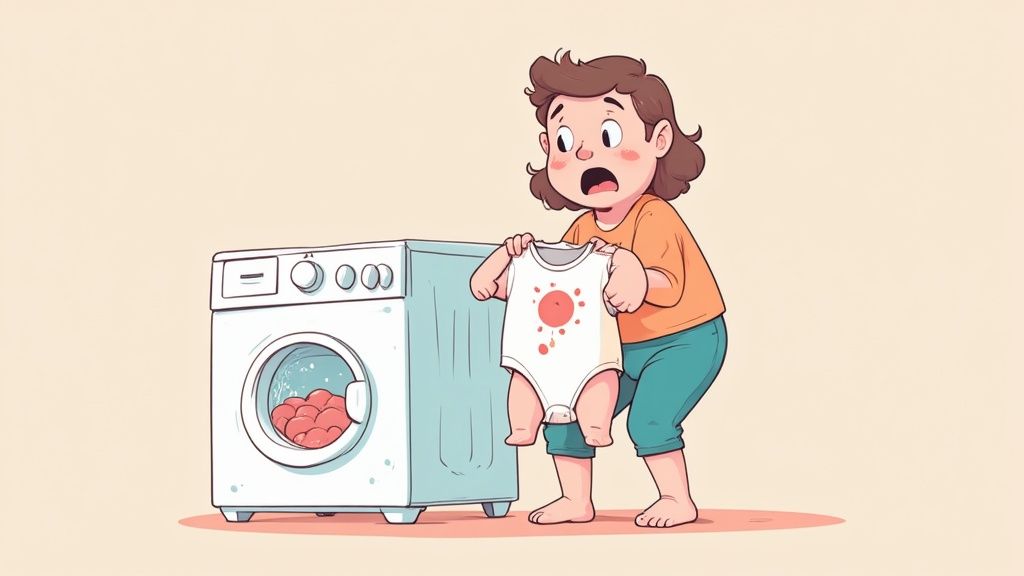
If you're a parent, you're already a member of the never-ending-laundry club, specializing in the art of stain removal. From those mysterious yellow spots that appear out of nowhere to the very obvious aftermath of a blueberry feeding session, the frustration is real.
But you don't need harsh chemicals to get the job done. This guide is all about practical, real-world advice that actually works for getting stubborn stains out of your baby's clothes.
Why Baby-Specific Cleaners Matter
A newborn's skin is incredibly sensitive and much more porous than an adult's. That means it’s more likely to react to the fragrances, dyes, and other chemicals packed into standard laundry detergents.
Choosing a baby-safe stain remover or detergent isn't just about clever marketing—it's about protecting your little one from rashes and skin irritation. These products are formulated to be hypoallergenic and gentle on skin but still powerful enough to tackle those tough messes.
The key to stain removal is understanding that you're not just cleaning a garment—you're caring for the sensitive skin that will be wearing it. Always prioritize gentle, effective solutions.
Quick Guide to Common Baby Stains
Before we get into the nitty-gritty, let's create a quick game plan. When a spill or blowout happens, it's easy to panic. But knowing exactly what to do in those first few moments can make all the difference.
Here’s a simple cheat sheet for the most common culprits. Acting fast with the right approach is what prevents stains from setting in for good and saves those adorable outfits from becoming rags.
| Stain Type | Immediate Action | Key Ingredient to Look For |
|---|---|---|
| Milk, Spit-Up, Poop | Rinse with cold water; scrape off excess solids. | Enzyme-based cleaners |
| Fruit & Veggie Puree | Blot gently; soak in a diluted white vinegar solution. | Acetic acid (vinegar) or citric acid |
| Diaper Cream / Baby Oil | Scrape off excess; apply baking soda to absorb oil. | Surfactants or degreasers |
Think of this table as your first line of defense. Taking that one immediate action sets you up for success when it’s finally time to do the laundry.
Decoding the Mess on Your Baby's Clothes
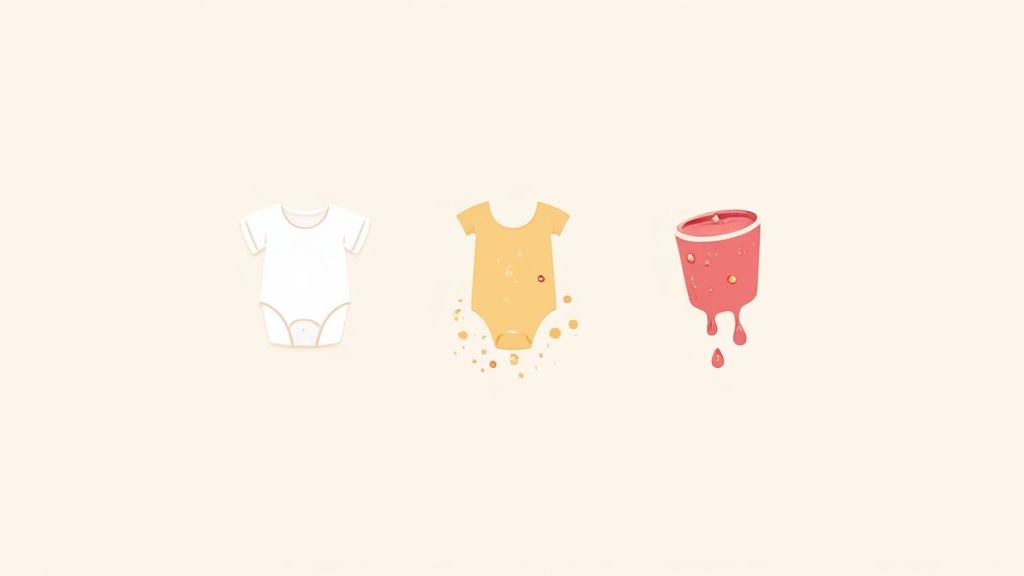
Let's be real—not all baby stains are the same. That yellow splotch from yesterday's sweet potatoes needs a different battle plan than the milky spit-up on today's onesie. Figuring out what you're up against is the first, and most important, step.
Once you identify the type of stain, you can pick the right tools for the job. It saves you from accidentally setting the stain forever and saying goodbye to another cute outfit.
Protein-Based Stains
This is your most frequent offender. We’re talking about milk, formula, spit-up, and, yes, the infamous diaper blowout. The common thread here is protein.
Here's the one thing to remember: protein sets with heat. If you hit these stains with hot water, you’re basically cooking the protein right into the fabric fibers. It's a one-way ticket to a permanent mark. So, the golden rule is to always use cold water for the initial rinse and soak.
Pro-Tip: Enzyme-based cleaners are your secret weapon against protein stains. These cleaners contain specific enzymes designed to break down protein molecules, lifting them from the fabric much more effectively than standard detergents.
Oil-Based Stains
Next up are the greasy messes. Think baby oil, Vaseline, and most diaper rash creams. These are tough because oil and water just don't mix, so a simple rinse won’t get you very far.
Your first move is to absorb the grease. Sprinkle a little baking soda or cornstarch directly on the stain and let it sit for 15-20 minutes. It will pull the excess oil right out of the fabric. After that, work a small dab of dish soap (a fantastic degreaser) into the spot to dissolve whatever’s left before you wash it.
Tannin-Based Stains
Welcome to the most colorful category of stains. This is where you'll find fruit juice, berries, tomato sauce, and that vibrant pureed carrot mash. The culprit here is tannin, a natural compound in plants that’s great at dyeing things—including that brand-new white sleeper.
For these bright stains, you have a few great options:
- A soak in diluted white vinegar can work wonders on breaking down the plant compounds.
- For light-colored clothes, try a little lemon juice and sunshine. It’s nature’s bleach.
- Oxygen-based bleaches are also incredibly effective at lifting these stubborn colors without harsh chemicals.
Knowing how to tackle these different messes is key to making your baby’s clothes last. When you invest in quality pieces, proper care makes all the difference. To understand more about what makes certain fabrics stand up to the challenge, check out this guide on why certain children's clothes last longer.
Building Your Baby-Safe Stain Fighting Toolkit
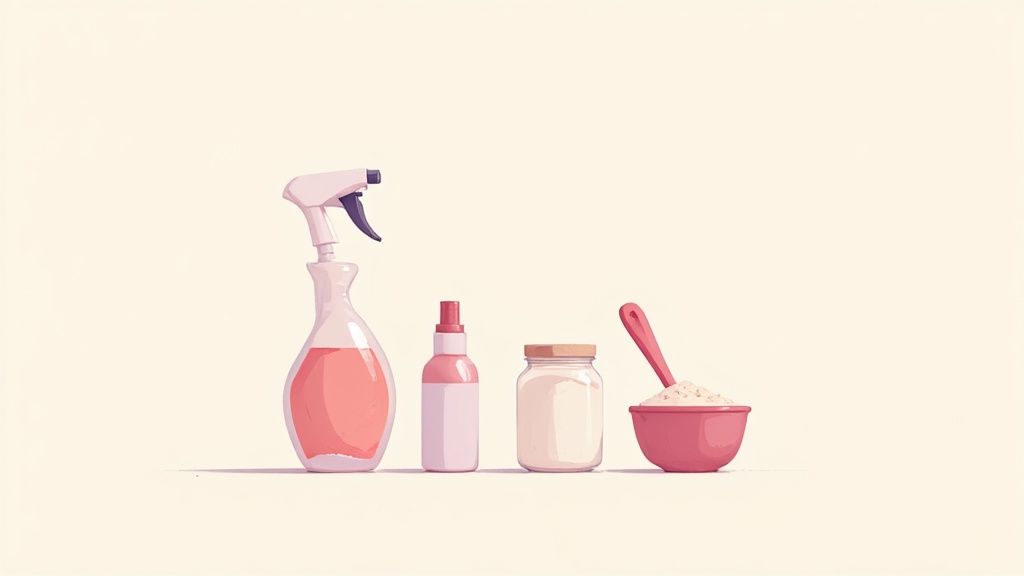
To win the war on baby stains, you need the right tools ready to go before disaster strikes. Having a well-stocked, baby-safe arsenal means you can act fast, which is honestly half the battle in preventing a stain from becoming a permanent resident on that cute new onesie.
Think of it as your first-aid kit for laundry emergencies. A few key products can handle almost anything your little one throws—or spits up—at their clothes.
Choosing Commercial Stain Removers
Walking down the laundry aisle can feel a little overwhelming. The baby care market is surprisingly huge; global sales for baby detergents alone were estimated at USD 642.6 million. That number jumps to nearly USD 1.42 billion when you add in stain removers and other products. You can dig into the specifics with industry research on baby laundry detergents.
So, how do you pick the right one? Always look for products labeled hypoallergenic and free of dyes and perfumes. A baby’s skin is incredibly sensitive, and the harsh chemicals lurking in standard removers can easily cause irritation or rashes.
Your goal is to find a product that's tough on stains but gentle on skin. An effective stain remover doesn't need a strong scent or bright color to work its magic.
Here’s a quick breakdown of what you'll find on the shelf:
| Type | Best For | Pros | Cons |
|---|---|---|---|
| Sprays | Fresh, wet stains | Quick application, covers large areas easily | Can be less concentrated, may overspray |
| Gels | Tough, set-in stains | Clings to fabric, great for targeted treatment | Can be messy to apply |
| Sticks | On-the-go treatment | Portable, precise application, no mess | May not penetrate deep stains as well |
For everyday messes, a good quality spray is a fantastic starting point. It lets you quickly saturate a fresh spit-up or food smear before it has a chance to dry and set in.
Powerful Household Remedies
You don't always need to buy a specialty product. Some of the best stain fighters I’ve ever used are probably already hiding in your pantry. These natural alternatives are cheap, completely safe, and surprisingly effective.
- Distilled White Vinegar: A champ at breaking down stains from fruits and vegetables. Just mix equal parts vinegar and cool water to create a pre-soaking solution.
- Baking Soda: This is your best friend for greasy or oily stains, like that pesky diaper cream that gets everywhere. Make a paste with a little water, and it works as a gentle abrasive to lift the stain out.
- Lemon Juice: Nature's bleach. It’s perfect for brightening whites and tackling faint food stains. Just dab a little juice on the spot and let the garment sit in the sun for an extra boost of whitening power.
- Sunlight: Seriously, never underestimate the power of the sun. Its UV rays are incredible at naturally bleaching out those stubborn yellow stains from milk or formula, especially on white cotton.
Having both a reliable commercial remover and these household staples on hand will prepare you for just about anything. For a deeper dive into washing routines, check out our guide on how to properly care for your child's clothes. With these items in your laundry room, you'll be ready for any stain emergency.
Practical Techniques for Tackling Common Stains
Alright, with your stain-fighting essentials gathered, it's time to get down to business. Dealing with baby stains is all about having a go-to game plan, whether you're up against spit-up, formula, or the abstract art left behind by a sweet potato puree. The secret is knowing a few core techniques that can handle almost anything your little one throws—or spits—at you.
This simple workflow breaks down the basics for saving baby clothes, from the initial mess all the way to the final wash.
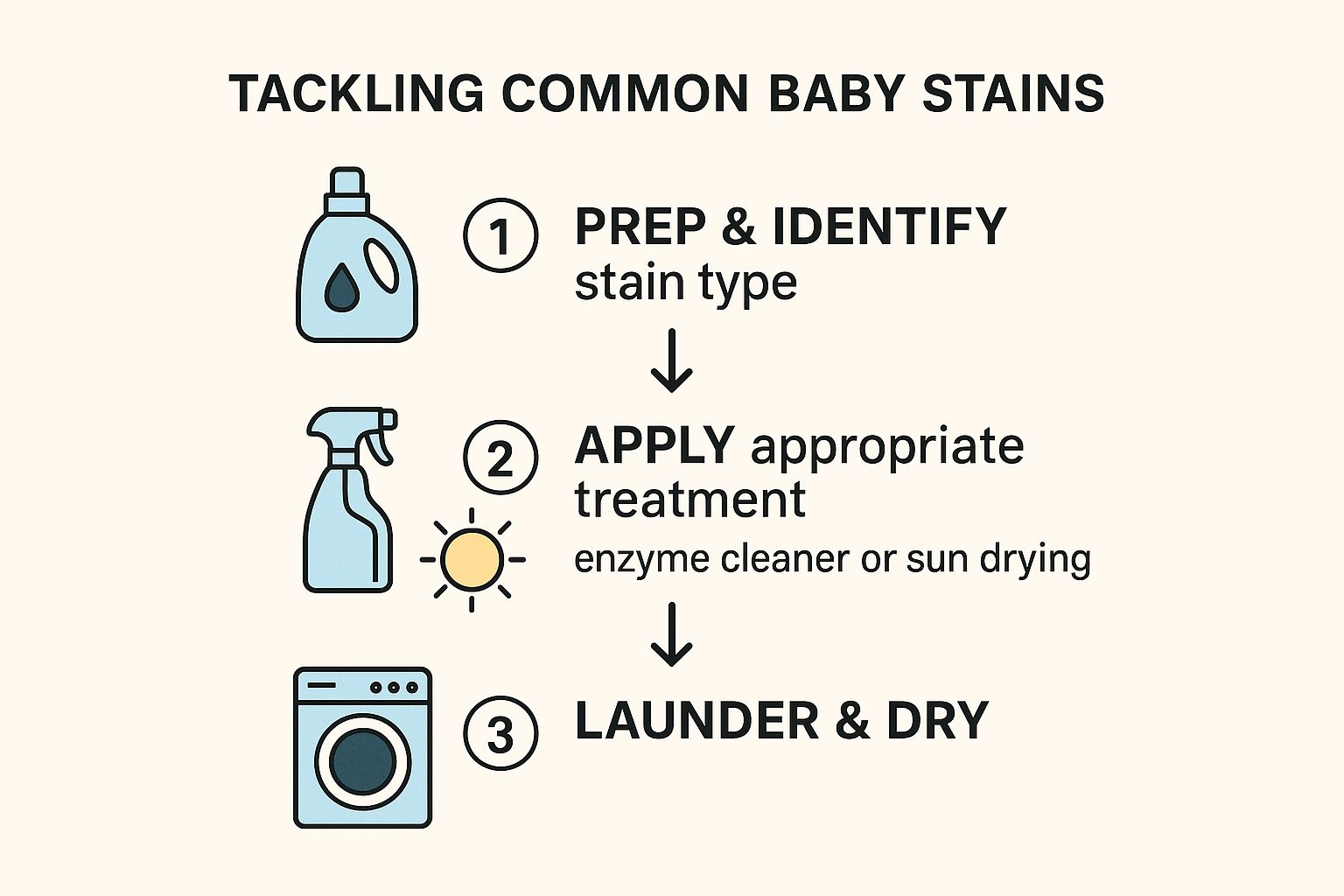
As you can see, a simple three-part strategy—prep, treat, and wash—is really all it takes to keep most of those adorable outfits out of the rag pile.
The First Response to Any Stain
What you do in the first few moments after a spill can make all the difference. Before you even reach for a stain remover, you need to deal with the mess on the surface.
First things first, scrape off any excess solids. A dull spoon edge or even a baby wipe works perfectly to gently lift away any bits of food, poop, or thick spit-up. This one small action prevents the stain from spreading or setting deeper into the fabric when you start rinsing.
Next, rinse the stained area with cold water from the back of the garment. This is a game-changing trick. Flushing water from behind pushes the stain-causing particles out of the fabric fibers instead of driving them further in. Always, always use cold water for protein-based messes like milk or formula, as hot water will essentially "cook" the stain right into the clothing.
Treating Milk and Formula Stains
Milk and formula are protein stains, and they need a specific kind of treatment to break them down. After that initial cold-water rinse, it’s time for your enzyme-based cleaner to do its thing. Enzymes are amazing little helpers that specialize in dissolving protein, fat, and sugar molecules.
Apply your stain remover directly to the spot. Whether you're using a spray, a gel, or a paste made from an enzyme laundry powder and a little water, be generous. Let it sit for at least 15-30 minutes before tossing it in the wash. For those stubborn, yellowed stains that seem to appear out of nowhere, you might need to soak the garment in an enzyme solution for an hour or more.
Pro-Tip: The popularity of stain remover sticks designed for baby clothes has exploded, contributing to a baby care market now valued at around USD 1.12–1.15 billion. This just goes to show how much parents rely on gentle, effective solutions for everyday messes. You can dig deeper into this trend by exploring these insights on the baby stain remover market.
Handling Colorful Food Stains
Once your baby starts on solid foods, your laundry basket will see a whole new rainbow of stains. From vibrant orange sweet potato to deep purple berries, you're now dealing with tannin-based stains, which act a lot like natural dyes.
For these bright messes, a gentle, acidic pre-treatment can work wonders. After rinsing the stain, give one of these methods a try:
- Vinegar Soak: Mix one part distilled white vinegar with two parts cool water. Let the stained part of the garment soak for about 30 minutes.
- Lemon Juice and Sun: This is a classic for a reason! On white or light-colored fabrics, dab a little fresh lemon juice on the stain and lay the item in direct sunlight. The sun acts as a natural bleaching agent, supercharging the lemon juice’s stain-lifting power.
After your pre-treatment, just launder the item as usual. These same ideas can be used for other tough, colorful messes. If you're tackling something more challenging, like paint from a craft session, our guide on how to get paint out of kids' clothes has more specific advice. By matching your approach to the type of stain, you can confidently rescue even the most colorful messes.
Conquering Stubborn and Set-In Stains
It’s a moment every parent knows well. You pull a favorite, cozy onesie from the warm dryer, only to see it—a faint yellow stain that's now been permanently baked into the fabric. My heart always sank when this happened.
But don’t give up and toss it in the rag pile just yet! With a bit of patience and the right technique, even those frustrating set-in stains can often be saved. When a stain has been set by heat, your game plan needs to be a little more intensive. You're not just lifting a fresh spill anymore; you're breaking down particles that have bonded deep into the fabric fibers.
Creating a Powerful Soaking Solution
For the really tough, set-in messes, your best friend is a long, restorative soak. This method is a lifesaver for those stubborn yellow marks left behind by old milk, formula, or spit-up. I've found that an oxygen-based bleach is a fantastic, baby-safe option. It works by releasing tiny oxygen bubbles that gently break apart the stain molecules without any harsh chlorine.
To get your soak started, here's what to do:
- Fill a basin, sink, or bucket with warm water.
- Add a scoop of oxygen-based bleach powder (think OxiClean Baby or another gentle brand) and follow the package directions for creating a soaking solution.
- Make sure the stained items are completely submerged and let them soak for at least six hours. Honestly, letting them sit overnight is even better.
This extended bath gives the active ingredients plenty of time to work their way deep into the fibers and break down that stubborn, set-in stain.
Set-in stains are such a common headache that the global stain remover market is now valued at a massive USD 16.86 billion. Parents are a huge part of this, always searching for products that are both effective and gentle on baby's skin. You can dig into these stain remover industry insights to see how the market is evolving.
Using Natural Pastes and Sunlight
If you'd rather go the DIY route, you can get great results with a simple paste made from baking soda and water. It's surprisingly effective. Just mix it into a thick paste, apply it directly onto the set-in stain, and gently rub it into the fabric. Let it sit for at least an hour before you wash the garment again.
Once you’ve treated and re-washed the item, do not put it back in the dryer. The heat will just set any remaining stain all over again.
Instead, let nature do the final bit of work. Lay the damp clothing out in direct sunlight. The sun's UV rays are a natural bleaching agent and work wonders on fading any lingering discoloration, especially those faint yellow protein stains. For me, this is often the final, magic step that completely restores white and light-colored clothes. It’s a crucial trick for anyone learning how to remove stains from baby clothes that seem impossible to beat.
A Few Common Questions About Baby Clothes Stains
Even when you feel like you've got a handle on the laundry, questions always pop up. Let's be honest, when you're figuring out how to get stains out of baby clothes, you run into the same challenges over and over. Here are some of the most common questions I hear from parents, along with simple answers to get you through any laundry-day surprise.
A little know-how goes a long way. It can take you from feeling overwhelmed to feeling like a certified stain-fighting pro.
Can I Use Regular Stain Remover on Baby Clothes?
It’s so tempting to grab that super-strong stain remover from the laundry room, but for baby clothes, it's best to stick with products made specifically for them. Your go-to remover probably contains harsh chemicals, heavy perfumes, and dyes that can easily irritate a baby's incredibly sensitive skin, which can lead to rashes and a very unhappy little one.
Look for baby-specific formulas—they’re usually hypoallergenic, often plant-based, and don't contain all those harsh extras. If you’re really in a bind, a "free and clear" version of a regular stain remover might work, but always do a quick spot test on an inside seam first. No matter what product you end up using, I always recommend running an extra rinse cycle. It’s a great way to be sure every last bit of residue is washed away.
How Do I Keep Stains from Setting in the First Place?
If there's one golden rule in the world of stain removal, it's this: act fast. The longer a stain has to sit on fabric, the deeper it works its way into the fibers. Time is truly your enemy here.
Here’s what to do the moment a spill happens:
- Scrape off any solids (think puréed peas) or blot up as much liquid as you can with a clean cloth.
- Turn the garment inside out and rinse the stain from the back with cold water. This pushes the stain out of the fabric instead of deeper into it.
- Whatever you do, stay away from hot water, especially for protein stains like milk, spit-up, or poop. Heat will essentially "cook" the stain right into the fabric.
My most important piece of advice: Never, ever put a stained piece of clothing in the dryer. The heat will set that stain permanently, and you’ll have a nearly impossible time getting it out. Always give wet clothes a quick once-over before they go into the dryer.
What About Those Old Yellow Stains on Stored Clothes?
It’s such a frustrating moment—you pull out a box of adorable, stored-away baby clothes only to find faint yellow splotches on them. Those mystery marks are usually caused by leftover milk or formula proteins that have slowly oxidized over time. The good news is, you can almost always get them out.
Your best bet is a good, long soak. Fill a sink or basin with warm water and add a scoop of an oxygen-based bleach powder (make sure it’s a baby-safe one). Submerge the clothes completely and just let them sit for at least six to eight hours. For really stubborn, set-in yellowing, I’ve even let things soak overnight.
After the soak, just wash them like you normally would with your favorite gentle, baby-safe detergent. And here’s a final trick for white or light-colored cottons: lay them out in the bright sun to dry. The sun has natural bleaching powers that work wonders on any lingering yellow, brightening the fabric right back up.
At Yarafly, LLC, we believe messes are just a sign of a good time. That's why we create clothes that are as tough as they are cute, ready for every spill, spit-up, and adventure. Check out our collections of comfy, playful, and easy-to-wash apparel at https://yarafly.com.